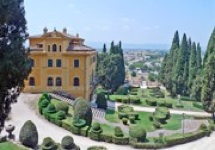
The villa stands on part of the site of what was an important Roman Sanctuary below the walls of Spello. Its grounds are open to the public.
Present layout
The history of the site is complex, so it is probably worth exploring the layout before looking at the way it has developed over time.
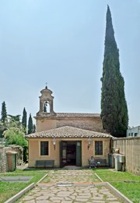
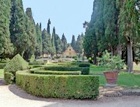
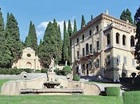
The main facade of the present villa is to the right. Although this building is very impressive, it was originally the Casino di Villeggiatura, a subsidiary structure added at some point soon after 1805 (see below).
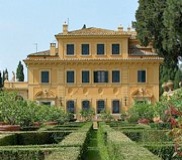
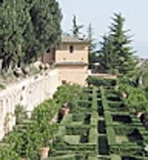
Casino di Villeggiatura (ca. 1805)) Urbani Villa
originally built in ca. 1600
Walk round to the far side of the present villa to see the Italian garden. This is laid out on a terrace, with the original villa (Casa di Villeggiatura) at the far end. This earlier building now belongs to the Suore Francescane Piccolo San Damiano.
Development of the Complex
Urbani Family (ca. 1600-1736)
The Urbani family, whose main residence, Palazzo Urbani, was inside the town walls, bought the site in ca. 1600 and used it principally for the cultivation of vines and olives. This smallholding extended across what is now the Via Centrale Umbra and included what were then the substantial remains of the Roman theatre (see below). The Urbani built a suburban residence, which was known as the “Casa di Villeggiatura” (the present nunnery of the the Suore Missionarie d' Egitto) at what is now the far end of the Italian garden. The family became extinct in 1736.
Funerary Stele (second half of 1st century BC)
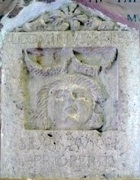
L(ucius) Cominius L(uci) f(ilius) Lem(onia)
The inscription is the earliest of nine surviving inscriptions that confirm that Hispellum (at least from the time of the formation of the colony in ca. 40 BC but possibly from the Social Wars, was assigned to the Lemonia.
The inscription below:
Sext(us) Aurel(ius)/ Propert(ius)/ Sex(ti) f(ilius) Lem(onia)
was added relatively recently (probably in the 18th century) when attempts were being made to claim the poet Propertius (who probably came from Assisi) for Spello.
Teresa Pamphili Grillo (1736-1762)
On the extinction of the Urbani family, its property passed to the Principessa Teresa Pamphili Grillo, a talented poet, who belonged to the Accademia dell' Arcadia in Rome and wrote under the pseudonym Irene Pamisia. She apparently wished to escape from a troubled marriage to Filippo Camillo Pamphili, who conveniently stayed in Rome. She was a very devout woman, and one of the attractions of this site in Spello was its proximity to Santa Maria degli Angeli, Assisi: when she died in 1762, she was buried there, and her cousin, Cardinal Cosimo Imperiali commissioned her monument (1764) from Tommaso Righi.
Teresa Grillo probably:
-
✴re-modelled the original Casa di Villeggiatura;
-
✴laid out the Italian garden; and
-
✴partially rebuilt San Fedele as a private chapel.
Gregorio Piermarini (ca. 1822-45)
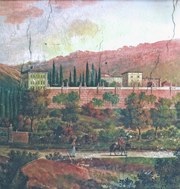
The property subsequently passed first to the Sperelli family and then to Gregorio Onori Piermarini of Foligno. He employed the engineer Saverio Andreucci di Siena to work on the site: his surviving plan (1830) of the site includes the ‘Casino di Villeggiatura’, which also appears in the fresco (ca. 1830) illustrated above, which survives in Piermarini’s palace (now Palazzo Piermarini Prosperi-Valenti) in Foligno.
Gregorio Piermarini died in 1845.
Recent History
The property subsequently had a succession of owners. It provided a summer residence for inmates of the Collegio Vitale Rosi until 1923, when it passed to its last private owner, Decio Costanzi. He sold the existing villa to the Suore Missionarie d' Egitto (now known as the Suore Francescane Piccolo San Damiano) in 1924, and commissioned Cesare Bazzani to re-model the Casino di Villeggiatura into what is now Villa Fidelia.
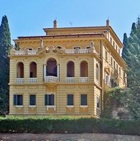
The present entrance to the grounds from Via Centrale Umbra and the garden leading up to the remodelled villa also took shape at this time. During this work, a fountain that had been fed by the Roman aqueduct was discovered and adapted to form the basis of the present monumental fountain.
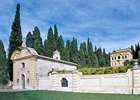
Decio Costanzi made his “new” villa available for the wedding breakfast of Giovanna di Savioa, the daughter of King Victor Emmanuel III, who married Tsar Boris III of Bulgaria in 1930 in a ceremony at San Francesco, Assisi that was attended by Benito Mussolini.
The Costanzi property passed to the Provincia di Perugia in 1974. The Straka - Coppa Collection, which Mario Coppa gave to the Province 1985, was housed in Villa Fidelia from that time until 2003. (It is now in the Palazzo della Provincia, Perugia).
Ancient History
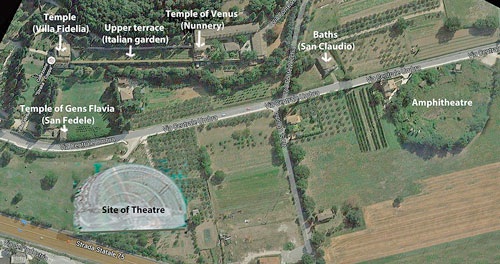
Aerial view of the site of the Roman sanctuary
The original Urbani smallholding covered a large part the Roman sanctuary (late 1st century BC), below the walls of Spello. The terrace on which the Italian garden was established is the uppermost of three terraces that were established at this time. There were twin temples at the ends of this terrace:
-
✴one on the site of the present Villa Fidelia (at the extreme left in the foreground in the image above); and
-
✴the other, which was dedicated to Venus, on the site of the original Urbani building (now owned by the Suore Missionarie d' Egitto).
Urbani’s holding also included:
-
✴the site of what was probably the Templum Flaviae Gentis (Temple of Constantine’s Flavian dynasty, built in ca. 335 AD), later the church of San Fedele (above), which can be seen in the reconstruction above on Via Centrale Umbra, at the centre of the foreground (just above the word ‘Santuario’ in its legend); and
-
✴land on the other side of what is now Via Centrale Umbra that had been to site of the Roman theatre.







